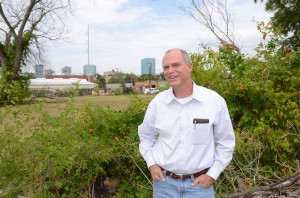
Between 2007 and 2011, the proportion of downtown residents who are 35 or younger increased from 37 to 43 percent. Within the next six months, construction will begin on a 256-unit complex on Samuels Avenue aimed at upwardly mobile young people, including both couples and college students.
“People moving here are coming from all over,” said Andy Taft, president of Downtown Fort Worth. “Downtown is getting younger.”
Interestingly, most of those living downtown and working full-time commute to a job outside of the downtown area. So the newer, younger residents aren’t choosing downtown because it’s practical. Like many of those moving to the Near Southside, they’re choosing it because it reflects who they are and what they want.
“They’re choosing downtown for the lifestyle,” Taft said. “Throw a dart and hit a city — it’s happening everywhere. Frankly, we were a little late. The good news is that young people love the inner city, and we are building products that they like.”
That “product” looks to sell well for years to come.
It’s unlikely that Eisner’s foray into Fort Worth housing will end with the Phoenix Apartments — he knows a good bet when he sees it.
“We’re going to be busy here for a while,” he said.
No doubt, but Texas cities have some serious work ahead of them if they are going to accommodate the needs of their new and growing population.
********
Those TCU marketing professors didn’t just ask young Fort Worth professionals what they liked about the city. They asked them what they didn’t like, too. The responses? Gas drilling, air quality, education, and the lack of public transportation.
Add urban sprawl, and you’ve got a pretty good list of the problems facing Fort Worth as it tries to accommodate the new residents coming in while encouraging more suburbanites to migrate back to the urban core.
Certainly, Fort Worth has long supported just about any gas well anywhere in the city. The small group of activists, both locally and statewide, who devote their time to pushing for tougher public safety standards for gas drilling have fought a losing battle for more than a decade.
But whenever someone was asked for this story what Texas cities must do to continue to attract new residents, the answer was always the same: public transportation. Which is probably the only thing Fort Worth has opposed more frequently than gas drilling restrictions.
“We were all a little behind the curve, but we’re working hard on it,” Price said. “It’s been a slow-moving process.”
That may be somewhat of an understatement. Plans to expand bus, rail, and streetcars have repeatedly gained traction only to be dropped by the wayside by the city council.
Streetcars running between downtown and the Near Southside, in particular, seemed to have the green light, backed by overwhelming public support and a years-long city study.
Paine believed streetcars could push economic development of the central city into overdrive, calling them “the last piece needed to light this place on fire.”
Then the plan was abruptly shut down by the city council, likely after downtown business interests expressed anxiety that they would lose customers to Magnolia Avenue.
“That’s my biggest criticism. We don’t have a comprehensive transportation plan,” Paine said.
Harwood, the city’s planning and development director, described the need for better transportation in even starker terms: “Transportation is the lifeblood of the city. If you’ve got no circulation, your body pieces start falling off.”
It’s not just about helping residents cope with the price of gasoline or spurring economic development, either.
Texas cities have become incredibly diverse. A recent Rice University study of census data concluded that Houston had the most ethnically diverse population in the country, with residents speaking 100 different languages. The problem is that those various communities aren’t really integrated. With better public transportation between isolated areas, that could change.
“Diverse cities tend to be centers of innovation,” Crotty said. “The work that needs to be done in designing cities is about making sure that people of diverse backgrounds actually interact.”
Price acknowledged Fort Worth’s poor record on public transit but promised last week, as she did during her campaign early last year, to push for more and better options. She said the 14-member passenger rail committee established by the council last month could help get things moving.
“You can’t have a city of a million people without great public transportation,” she said. “We’ve put a new focus on it.”
Though Fort Worth is likely still years away from adequate buses, rail lines, and streetcars, the city’s expansion of bike lanes and trails was mentioned as a plus by nearly everyone interviewed for this story.
The city announced last month that it will receive a $1 million federal grant for a bike-share program. The city bus system, also known as The T, will use the money to install 30 racks where riders can use credit cards to rent one of 300 bicycles. Bikers now have more than 50 miles of bikes lanes on city streets, and there are plans for many more.
Among Fort Worth’s many bike groups, the mayor has become something of a mascot, a leader who represents part of the youthful, health-conscious identity that attracts young and old alike. In a way, it’s taken as a sign that the city may finally be listening to this growing group of voices.
Harwood stressed that cities must continue to accommodate these young professionals, who he said will foster a “creative culture” that will then stimulate the economy and attract a broader segment of the population.
“Many other people need to move back to the inner city eventually, but young people have to start it,” he said. “Not only do you have to get them to come, you have to get them to stay.”
He’s talking more or less about the “creative class” famously described by economist Richard Florida, who made a similar argument in a best-selling 2002 book. The theory has drawn some criticism about whether the group of middle- to upper-income people Florida describes actually corresponds to economic growth, with some studies suggesting otherwise.
In the Near Southside, at least, there is some evidence for it.
From 2008 to 2010, during one of the worst recessions on record, the area’s property values nearly doubled, from $288 million to $401 million, while values fell citywide by 18 percent.
And regardless of whether the creative-class theory holds up to scrutiny, it’s becoming clear that urban sprawl is unsustainable for both the economy and the environment. That’s especially evident in North Texas, where there is little to stymie outward growth.
For decades, the combination of Texas’ cheap, empty land and cheap gas didn’t create much of an incentive for living in close quarters.
“I’m curious to see what will happen in Dallas-Fort Worth, because it’s an entire area based on the idea of suburban sprawl,” Crotty said. “We have projections that say we’re going to go up to 10 million people by 2020. Where those people are going to live is a big question.”
Crotty teaches in TCU’s Institute for Urban Living and Innovation. Students there not only study economic and population trends of cities but must actively participate in community outreach. The institute funded the creation of the Fairmount Community Garden, for example.
The garden “is part of driving what we view as positive changes in these communities,” Crotty said. In the long run, areas like the Near Southside are “much more sustainable in terms of economic growth” than endless suburbs.
Price acknowledged that the rapid population growth in far north Fort Worth has led to typical problems associated with urban sprawl. Police Chief Jeff Halstead warned the council early this month that it can take as long as 10 minutes for officers to respond to a call from the northernmost parts of the city.
Problems like that increase the cost of city services to everyone.
“We’re not going to exclude those who live in the suburbs,” but it’s important to draw residents into the city center “to set that example,” Price said.
Fort Worth, like the rest of Texas, has a ways to go to reach the finish line, but Harwood feels confident the city can get there.
“Ten years ago, we realized we were too spread out,” Harwood said. “We can deliver. We can solve the transportation problem. Other cities have.”
In the meantime, the city will continue to appeal to young people because of its personality, because it has something you can’t sell or translate into a marketing campaign, Harwood said.
He calls it an edge.
“There’s a uniqueness to Fort Worth that’s almost like a specific genre of country music,” he said. “The attraction is that you can’t really package it. … which is good. It makes us genuine.”












Very well written. Anyone interested in what is going on in this city should read this. Great to see all of the main players talking to the Weekly too. The times they area changing. Just hope this city stays on track.
I am so glad that Fort Worth is making so many positive changes that attracting notice and enthusiastic new residents. The author forgot about two major pieces of the puzzle that needs to fall in place if the city wishes to retain these young residents as their children get older.
1. Many of the Parks Department facilities need updating and renovations if the city wishes to remain competitive with some of the other large cities in the area such as Arlington who have stayed ahead of this issue. If you want to see an example of a vibrant city park of the type that Fort Worth needs and deserves visit River Legacy Park in Arlington. This huge park on the banks of the Trinity includes a privately nonprofit run Nature Center that offers free programs almost every weekend as well as a classes and summer camps, pavilions and open space for picnics, a brand new state of the art playground, extensive roller blading, biking and walking trails that extend out into the surrounding community, a canoe launch, and the crown jewel- more than 1,000 acres of wilderness along the river for walks and hikes.
2. While some of the individual FWISD school are excellent, there are a lot of problems system-wide and with many of the individual schools. Families with young children may choose to stay in Fort Worth but once their kids reach kindergarten age they will continue to flee to the burbs if this issue isn’t better addressed.